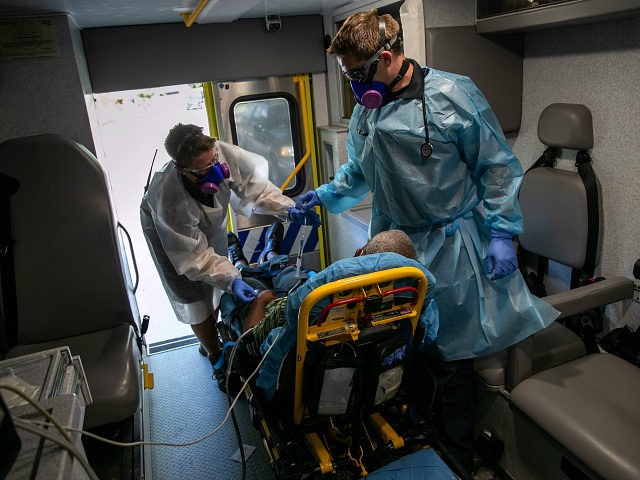Experts at the Institute for Health Metrics and Evaluation (IHME) at the University of Washington offered a dire forecast this week, predicting over 410,000 total coronavirus-related fatalities in the United States by the start of the new year and warning that the “worst is yet to come.”
The most recent prediction from the IHME, which has come under tremendous scrutiny over the course of the Chinese coronavirus pandemic for its pattern of failed projections, shows 410,451 coronavirus deaths by January 1, 2021 — over double the 186,800 deaths currently reported in the U.S. from the start of the pandemic.
Under the worst-case scenario, which sees “mandates easing,” IHME predicts over 620,o00 fatalities. That number could be reduced to less than 288,400 in the event of a universal masking policy, according to the forecast.
“The worst is yet to come. I don’t think perhaps that’s a surprise, although I think there’s a natural tendency as we’re a little bit in the Northern hemisphere summer, to think maybe the epidemic is going away,” IHME director Christopher Murray told reporters on Friday.
Murray said that the number of fatalities will depend on a variety of factors, including the speed of the nation’s reopening plan as well as mass adherence to coronavirus restrictions. However, despite IHME’s best-case scenario, which features universal masking, Murray told reporters that mask use “likely won’t be enough to drive down spread of the virus in the fall and winter,” as CNBC News reported.
“He said the question, from a policy perspective, is what kind of social distancing restrictions will be most effective, and there’s not enough public data to answer that question, he said,” the outlet added.
Overall, Murray said that “we are facing the prospect of a deadly December, especially in Europe, Central Asia, and the United States.” That is due, partially, to the uptick in individuals spending time indoors in the winter, where the virus can more easily spread.
“People in the Northern Hemisphere must be especially vigilant as winter approaches, since the coronavirus, like pneumonia, will be more prevalent in cold climates,” Murray explained.
IHME’s projections have remained wholly inconsistent throughout the pandemic, particularly for “vastly overstating projections of regular and ICU hospital beds needed,” as Breitbart News detailed.
In early April, the IHME model indicated that only 13,010 regular hospital beds were available across the state of New York — a significant error, as Gov. Andrew Cuomo (D) announced 90,000 available hospital beds, roughly 77,000 more than the model stated.
That same month, IHME dramatically dropped peak hospitalization projections for the United States by 34 percent over the span of just three days, revising its forecast from 86,479 total hospital beds needed to 56,831. IHME attributed the dramatic reduction to its own inaccurate prediction after observing “actual hospitalization data” from April 10-12.
“A review of the April 13 release of the IHME model late Monday showed an even lower total hospital bed requirement at the peak date (56,831) than the 59, 592 projected in the update released earlier in the day,” as Breitbart News reported.
Similarly, IHME drastically reduced its projections for U.S. coronavirus deaths just days prior, reducing its own prediction by 25 percent and failing to initially provide an explanation for the change. At the time, the change marked “the second reduction in the model’s U.S. deaths projections since April 1, when it forecast 93,765 U.S. fatalities.”
A spokesperson for IHME later told Breitbart News that the change stemmed from “new data” from multiple states.
“Our estimates assume statewide social distancing measures are continuing in states where they have already been enacted, and for those states without such measures in place, it is assumed they will be will be in place within seven days,” Murray stated in early April, warning that the death toll and peak, as well as hospital capacity, would be “much greater” without proper social distancing measures.
“As we obtain more data and more precise data, the forecasts we at IHME created have become more accurate,” he said in the April 5 release. “And these projections are vital to health planners, policymakers, and anyone else associated with caring for those affected by and infected with the coronavirus.”
Still, projections have continually bounced around since the start of the pandemic, prompting White House Coronavirus Task Force coordinator Dr. Deborah Birx to question the accuracy of the model.
“I think that particular model is very sensitive to actual any changes in the mortality and very much utilizes that data,” she told reporters in May:
Birx said she looked forward to an IHME model adjustment in another week, pointing out that their prediction for deaths expected on Tuesday was already higher than the actual data.
She also said that the model likely failed to note the continued mitigation parameters in both phases of the reopening plan.
“I’m not sure all of the mitigation parameters were taken into account,” she said.
IHME predicted 134,475 deaths in the U.S by August 4 in a May 4 forecast.
The peer-reviewed ACP Journal has issued a caution on using the IHME model in “predicting the course” of the virus, explaining that IHME’s projections are “based not on transmission dynamics but on a statistical model with no epidemiologic basis.”

COMMENTS
Please let us know if you're having issues with commenting.